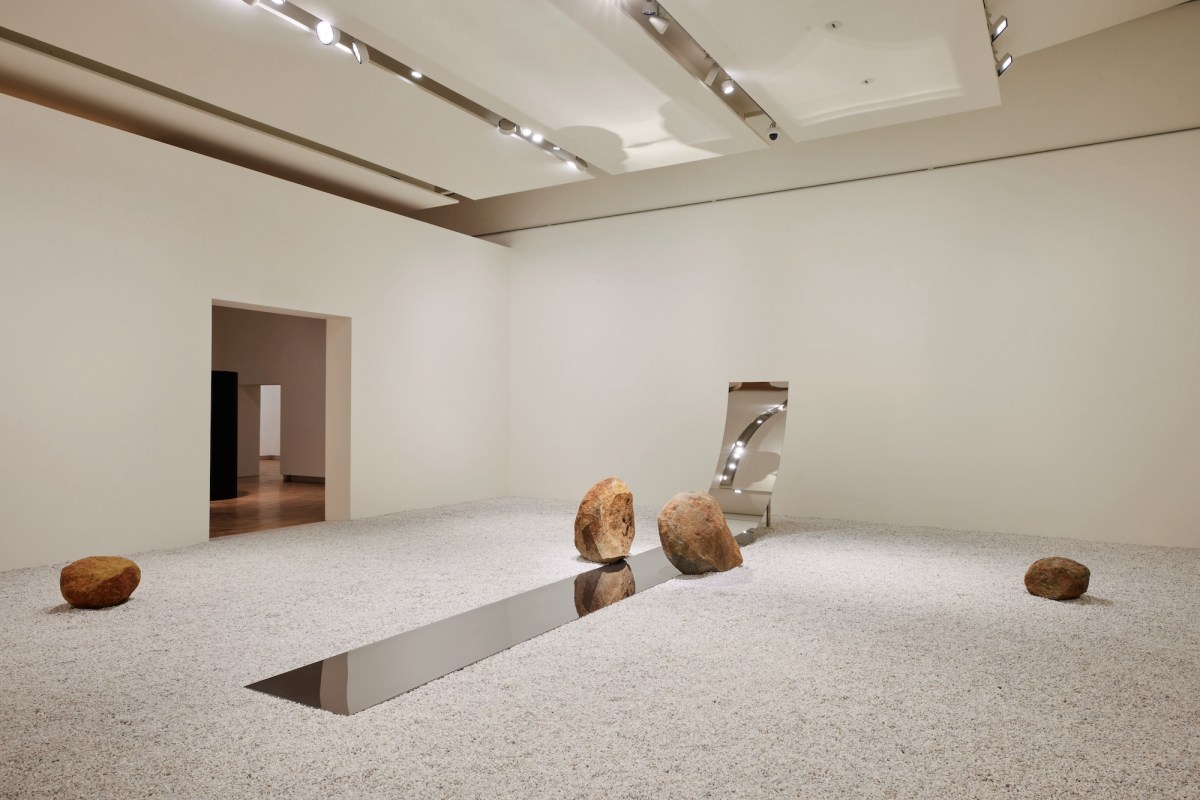It feels appropriate that Lee Ufan’s Art Gallery of New South Wales (AGNSW) exhibition Quiet Resonance feels modest or understated.
It’s presented in AGNSW’s Asian Lantern galleries, and visitors approach this solo exhibition with a sense of pilgrimage. After all, Ufan was a founder of Japan’s Mono-ha (School of Things) movement in the 1960s, and is cited as a influence on prominent artists Anish Kapoor, Park Seo-Bo and Pritzker Prize-winning architect Tadao Ando.
That sense is confirmed immediately. Alongside the welcome text for his exhibition – the first by this celebrated Korean artist in an Australian institution – is the poetic statement: “Space, stones and steel plates, previously unrelated, suddenly begin to call each other and come together to make one work of art.”
Ufan is an artist who, for six decades, has celebrated the relationships between natural and industrial materials, that between objects and their viewers, and the balance between rocks and either sheets of mild steel or mirror.
The first piece encountered is Relatum – position 1968/2024, where, with minimal intervention, he allows the natural placement of a stone on a mild steel sheet, inviting us to consider the forces of that meeting – the weight of stone, the surrounding space created by their configuration, our proximity to the objects and their scale. These are all things considered in ‘relation’ to the other, or Relatum, the title he has used for all his sculptural works since the early 1970s.
Just like viewing the Mona Lisa, or van Gogh’s The Starry Night, Lee Ufan’s work carries its own seismic moment, when faced with the very palpable energy of viewing his works. Few living artists can boast having three museums dedicated to their work: Space Lee Ufan in Busan (Korea), the Lee Ufan Museum on Naoshima Island (Japan) and Lee Ufan Arles in France.
That journey of connection started with AGNSW almost 50 years ago, when Lee’s work was presented in the 3rd Biennale of Sydney in 1976. It is quite remarkable to think that, at 88, he has returned to Sydney with a whole new series of pieces created for this show.
The Biennale work was Situation II, a work comprising a single lightbulb suspended over a bare canvas on the floor. As part of this current exhibition, Lee has delivered a reworking – or extension, as he calls it – of this original piece. Here he has added a large boulder to that lightbulb configuration, still playing with the interplay of illumination and shadow, but volumising the space more dramatically.
A highlight in the group of works – just four paintings and four sculptures – is the room-sized installation Relatum – to heaven road (2024), which pairs a long ribbon of mirror that arcs from the wall and across a Zen field of white pebbles, with a collection of like-sized boulders. The warmth of the stone juxtaposed with the cool, slick reflective mirror has both a tension and a balance.
Viewers are invited to walk across the stone garden, enjoying the crunch of the pebbles and catching fragments of their image in the mirror. The piece, while new, pays a nod to a series of works made in 1970 for Tokyo National Museum of Art, and demonstrates the singular, career-long focus that Lee has followed with precision and passion.
The four paintings in the exhibition were created between 2022 and 2024 and sit in a separate room. All in a large portrait format, they are essentially fields of white, with dragged smears of saturated colours in those same earthy, stone tones. Exactly the same principles are at play, contrasting the natural with the neutral.
Sitting at the edges of the exhibition is a display of works that explore the same ideas that have concerned Lee over his entire career. Whether ceramics, works on paper or wall-based sculptures, these pieces connect a shared minimalist movement from Japan to Singapore to New York to Australia.
Curator Melanie Eastburn has done a lovely job in expanding the exhibition.
Inspired by his time in Sydney, Lee has also created some impromptu wall art titled Drawing – open space in the Gallery, and on the grass outside Naala Nura, Relatum – stone family, with two of the stones hand painted.
This clearly warm connection with AGNSW has been further cemented with the announcement of a sculpture commission to be installed outside the Gallery next year, alongside 7000 oaks (7000 Eichen) by Joseph Beuys, “acknowledging that the two artists were contemporaries,” says the Gallery in a statement.
Whether you are a fan of minimalism or not, this exhibition offers a calm that so many hanker to find today. It is also a stellar example of how the history of contemporary Asian art is stitched together with Australia’s own expansive view of contemporary practice, and how it has been collected over time.
All the stones for these new works have been sourced across regional NSW.
Lee Ufan: Quiet Resonance
Curator: Melanie Eastburn
Asian Lantern galleries
Naala Nura, the Art Gallery’s original building
31 August 2024 to September 2025
Free entry





